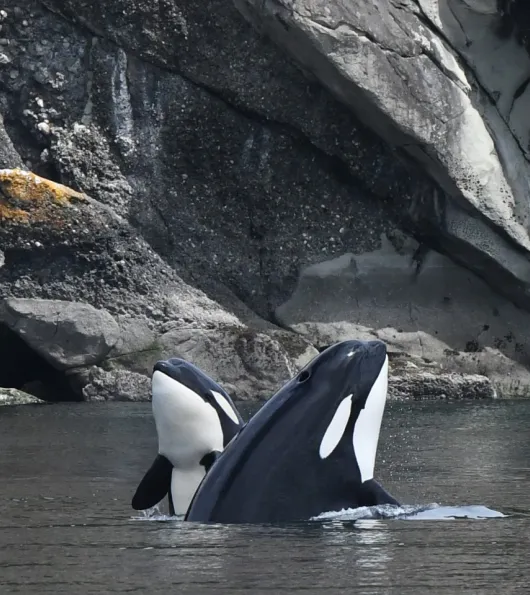About Whales
Whales of the Salish Sea
.

The salmon [and therefore, the SRKWs] would make their way from the Fraser River in Canada down past the west side of San Juan Island, making Lime Kiln Lighthouse a formerly famous spot for viewing orcas from shore.
Salmon are recognized as being one of the Pacific Northwest’s keystone species all the way up through Alaska. They play a critical role within these ecosystems - the health and survival of many other species are dependent upon them. Salmon also holds a deep cultural and economic significance for many communities. Not only does their abundance have a large effect on the food web either as predators or prey, but their presence helps maintain biodiversity and ecosystem health. Salmon is a huge food source for bears, birds, marine mammals, and other fish species, meaning their decline has cascading impacts in every direction of the food web.
Additionally, the salmon population plays a huge role in nutrient cycling in freshwater environments. They are born in freshwater ecosystems [such as rivers and estuaries], where they travel towards the open ocean and spend their adult life growing large in saltwater. After a few years, the salmon return to the very fresh water they were born in, carrying marine-derived nutrients inland, and then spawn. After spawning, their deceased bodies release nutrients into the ecosystem, enriching soil and supporting plant life, including trees! Overall, the salmon’s life cycle represents the connection amid marine and freshwater ecosystems and maintaining a balance between them.
Presently, the Chinook Salmon population in the Salish Sea is decreasing. Not only measuring smaller in terms of body weight and length, but their population is on the decline due to many factors including overfishing, habitat loss and degradation, runoff into natal freshwater environments, dams, climate change, ocean conditions, and hatchery influence.
Since the Southern Resident Killer Whale distribution and population rely entirely on where the salmon are and their population size, this orca population is critically endangered and are expanding their historical distribution. Recent studies show that they are spending more time offshore following other salmon runs, and have traveled as far south as Monterey Bay, California, and as far north as Alaska. While SRKW visits are seldom in the Salish Sea, they most commonly occur during the winter months, and rarely during the summer months.
Furthermore, additional protection has gone into place surrounding the vicinity of these visits, and as of January 1st, 2025, per RCW 77.15.740, motorized and non-motorized vessel operators [including commercial, recreation, ferries, kayakers, and paddleboarders] in Washington waters must stay 1,000 yards away from Southern Resident Killer Whales.
By choosing San Juan Safaris and San Juan Island Outfitters for their whale watch and sea kayak tour experience, guests contribute to conservation efforts aimed to help the salmon population, and thus, the Southern Resident Killer Whale Population. For every tour ticket sold, $2 is donated to orca and salmon conservation. Since the inception of the Conservation Fund in 2015, San Juan Safaris and San Juan Island Outfitters have donated over $200,000 to three primary organizations: The Center for Whale Research, Save Our Wild Salmon, and Long Live the Kings as well as smaller donations to The Whale Museum, San Juan County Land Bank, San Juan Preservation Trust, and the Shaw Centre for the Salish Sea.
_____________________________________________________________________________________________
- Bigg's Killer Whales
Also known as Transient Orcas, this population can be found traveling throughout a broad distribution, ranging from California up to Alaska! This ecotype is growing at an exponential rate and solely feed on marine mammals. While the Harbor Seals are their primary food source consisting of over 70% of their diet, they will also feed on porpoises, sea lions, and even baleen whales!
With a healthy population of Harbor Seals and other marine mammals in the Salish Sea, these orcas visit more frequently and stay for longer periods of time. Reflecting on sighting data from the Pacific Whale Watch Association the past few years, Bigg's Killer Whales have been spotted every month of the year at an increasing rate. This makes them the most common whale sighting on our trips from March through October.
- Humpback Whales
One of our favorite success stories! While Humpback Whales were abundant in these waters over a 100 years ago, their population was depleted during the whaling era. It wasn't until the early 2000's that they were spotted returning to these waters, and up until this most recent decade, sightings were few and far between. However, in the past few years, we have noticed a significant increase of Humpback Whales migrating back here from both Hawaii and Mexico, where we have documented over 800 individuals in the Salish Sea. While there is so much to say about this event, it has been a humbling experience for us all and they have become the second most common species of whale we see in these waters.
- Minke Whales
The Salish Sea is home to a small population of Minke Whales that are most commonly seen south of the islands, despite the fact that they can be found in all of these waterways. Not only are they smallest baleen whale, they are known to be lunge feeders following the contour lines along shallow bank
- Gray Whales
These whales are popping into the Salish Sea to feed on ghost shrimp during their seasonal migrations. Sightings of these benthic feeding baleen whales have been increasing the last few years where we have noticed a trend where they are coming earlier and staying for longer durations of time.

YOU NEED TO FOLLOW THE RULES TO PROTECT THE ORCAS
Whale Watching Guidelines
As an active member of the Pacific Whale Watch Association (PWWA), San Juan Safaris follows all guidelines for respectful and safe wildlife viewing. Owner and Captain Brian served as the president of the organization for 3 terms and is now an active board member.

EVERYONES GOT QUESTIONS, WE'VE GOT ANSWERS
Whale Watching FAQ
From the best months to visit - to whale sighting guarantees, we try to cover all the basic questions we commonly get here.
If we don't cover it here, we'd love to chat with you to learn more about how we can help!